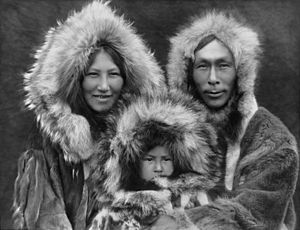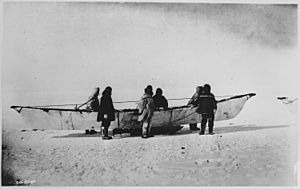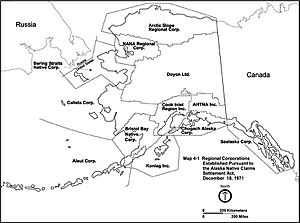Subsistence hunting of the bowhead whale facts for kids
The subsistence hunting of the bowhead whale is a special kind of hunting allowed by the International Whaling Commission. This means that while hunting whales is mostly banned around the world, some Native peoples in North America, like the Eskimo and Iñupiat people in Alaska, can still hunt the Bowhead whale. This type of hunting is very important for their food supply and their way of life. It's different from the old days when people hunted whales for business.
Contents
The Iñupiat People and Whaling
For the Iñupiat people in Utqiagvik, Alaska, the bowhead whale is super important. They believe their lives are deeply connected to the whale. The whale is central to their food, their culture, and their spirit. They share the whale meat and celebrate their hunts. They even pray to a whale they have caught, thanking it for providing for them.
Hunting for Food and Life
For the Iñupiat, hunting and fishing are key ways to get food and materials for their community. When hunters bring a whale back, many people work together to pull it onto the ice. Then, about 65 to 70 people work all day to cut up the whale and gather its meat. They work fast so the whale's body heat doesn't melt the ice too much.
After the hard work, the hunting captain and crew invite everyone to a big meal. The captain takes what his family needs, then shares the rest of the whale with the community. This sharing makes sure everyone has enough food.
Why Some Young People Hunt Less
Even though hunting is very important, fewer young people are joining the hunts. This can happen for several reasons. Some young people might not have enough training or the right equipment. Their food choices might be changing, or they might just not be as interested. Also, more people are working jobs for money, and young people might be busy with other activities like basketball, hockey, or baseball.
The Hunt and Its Tools
Hunters are proud to provide for their families and communities. People in the Inuit community describe good hunters as those who:
- Always share meat with others.
- Are ready to hunt at any time.
- Travel in all seasons, not just spring.
- Know a lot about traveling in cold weather and on sea ice.
When they go hunting, they travel across the ice on snowmobiles. They look for a safe camp spot, which can take a whole day. The camp needs to be near solid ice so hunters can quickly move to safety if needed. They hunt from an umiak, which is a boat made from seal hide and caribou parts. They use harpoons and dart guns to catch the whales.
How Whales Are Used
The whale's meat and organs provide most of the food. The Iñupiat people say that the whale's maktak (its thick black skin and oily blubber) gives them energy and vitamin C. This helps them stay warm. The whale's bones are used to build the frames of sod iglus (igloo). The flexible baleen from the whale's mouth is woven into baskets. Even the liver membrane is used to make drums.
Laws About Hunting Whales
Having enough food for everyone is called "food security." The United Nations’ Food and Agriculture Association (FAO) says food security means people can always get enough safe and healthy food for an active life. Because of this, laws are needed to allow hunting in Alaska, even with efforts to protect animals.
Important Acts for Native Rights
In 1971, the U.S. Congress passed the Alaska Native Claims Settlement Act (ANCSA). This act removed old land claims by Native Alaskans. Instead, it gave Native groups 44 million acres of land and about $1 billion. However, this act did not protect their right to hunt for food. So, Native groups looked to other laws for help, like the Migratory Bird Treaty Act of 1918, the Marine Mammal Protection Act of 1972, and the Endangered Species Act of 1973.
Then, in 1980, the Alaska National Interest Lands Conservation Act (ANILCA) was created. This act specifically included rights for Native Alaskans, Eskimos, and Aleuts to hunt and fish for food. ANILCA also protected over 104 million acres of federal land, including many parks. Under this act, Native peoples are allowed to hunt for food in several new and expanded parks.
Both the state of Alaska and the federal government manage these hunting laws. The state laws cover hunting for "all Alaskans" on state and private lands. Federal laws cover hunting for "rural residents" on federal lands. They work together to manage these rules.
Getting a Hunting Permit
To hunt for food in Alaska, you usually need a permit. The laws mentioned above allow any Alaskan resident to apply for these permits. Many of the rules for subsistence hunting are similar to Alaska's regular hunting laws.
- If you are under 16, you must have completed a Hunter Education course. Or, you must be with someone over 16 who has completed the course or was born before January 1, 1986.
- You must apply for permits between November 1st and December 15th. Late applications are not accepted.
- Sometimes, game can be hunted outside the normal season or beyond the usual limits if it's for traditional Alaska Native religious ceremonies.
Permits are given to those who score highest on their application questions. Each application is scored on five questions. Permits are given out starting with the highest scores until all permits for that hunt are gone. Hunters can apply for more than one permit, but they can only hold one permit for each type of animal they want to hunt. Permits cannot be given to another person, unless it's for military personnel deployed to a combat zone.
When hunting, you must carry your permits, a valid hunting license, and any necessary big game tags. At the end of the hunting season, all permits must be returned, even if you didn't use them.
Hunting Limits (Quotas)
The IWC sets a limit, called a quota, on how many bowhead whales can be hunted each year. For example, in 2020, the quota was 100 whales. Seven were for Russia, and 93 were for the United States. In the US, hunters struck 69 bowheads, and they were able to bring 54 of them to land.
Bowhead Hunting in Arctic Canada
The Inuit people in Canada have hunted whales for a very long time, even before European whaling ships arrived in the 1700s. They had to stop hunting whales from the 1940s but were able to start again in the 1990s. Only a few hunting licenses are given out each year. The hunt is watched and managed by several groups, including the Nunavik Marine Regional Wildlife Board, the Nunavut Wildlife Management Board, and the Department of Fisheries and Oceans.




